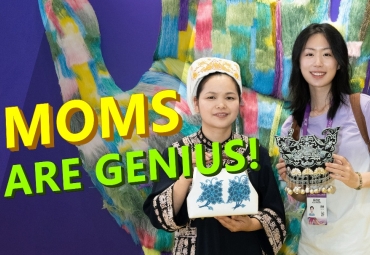Ancient handicraft finds new purpose

Zhang Xiao (left) tries out different stitches of Dong embroidery under the guidance of embroiderer Lu Yongjiang (right) in Liping county in Qiandongnan Miao and Dong autonomous prefecture, Guizhou province. CHINA DAILY
Zhang Xiao, a 17-year-old boy from Zhuhai, Guangdong province, has always been interested in traditional Chinese handicrafts. And this summer, he embarked on an extraordinary adventure to a small county called Liping in Qiandongnan Miao and Dong autonomous prefecture, Guizhou province, where the famous Dong embroidery was born.
Upon arriving on June 21, Zhang stepped into a shop called Yanting Embroidery Art and Culture Studio. "The walls were decorated with stunning pieces of embroidery and the table was covered with fabric and partially completed works," said Zhang about his first impression of the studio. "The embroiderers, dressed in traditional Dong costumes, were skillfully sewing each stitch with great precision."
Growing up in a coastal city, Zhang, a senior student at The Affiliated High School of South China Normal University, was immediately captivated by the cultural charm of the Dong ethnic group residing mainly in southwestern China.
The studio was founded by local embroiderer Lu Yongjiang, a provincial-level representative inheritor of Dong costumes. Under the guidance of Lu, Zhang began to learn the basics of Dong embroidery techniques, including flat, crossed and knotted stitches. "It is really challenging to sit still for hours while completing these stitches with utmost accuracy," he said.
Dong embroidery is a traditional ethnic art form that incorporates techniques including spinning, dyeing, weaving, paper cutting and embroidery. In recognition of its cultural significance, Dong embroidery was included in the third batch of China's national intangible cultural heritage in 2011.
"You can see unique ethnic characteristics in these pieces of needlework, featuring vibrant colors and distinct styles," said Zhang. "Some Dong people also embroider ethnic stories on their own clothes."
In the absence of written language, according to him, ancient Dong people would record and weave their history, legends, gods and other cultural elements into various fabrics and ethnic costumes. Even today, handmade embroideries continue to hold great significance in the lives of local Dong people, with the wisdom of their ancestors preserved in every stitched design of flowers, insects, fish and stars, as well as many other patterns.
Zhang used to worry that this ancient art form would one day be replaced by machine manufacturing. But after personally trying Dong embroidery, he's confident that this is unlikely to happen.
"Different from the repetitive up-and-down motion of machine-driven sewing needles, Dong embroidery involves a variety of stitches that can be combined in various ways," he said. "As a result, each finished piece is unique and personalized, so achieving this level of individuality and craftsmanship is challenging for machines."
Even though Dong embroidery stands out from machine-made alternatives, somehow, it doesn't do well in the market. According to Zhang, one of the reasons might be its high price due to its intricate techniques. For instance, some palm-sized embroidery pieces sell for thousands of yuan.
"I have also noticed that the customer base for this embroidery studio mainly consists of middle-aged and elderly people who rely on recommendations from acquaintances and word-of-mouth advertising," said Zhang. He believes that there are still many opportunities to expand the market and attract young customers, especially Generation Z, who's been growing up in the age of the internet.
After discussing it with Lu's team, Zhang helped her studio establish an online store on Taobao, a popular Chinese e-commerce platform. He also proposed that the studio should collaborate with bag and clothing companies by embellishing some of their products with small pieces of Dong embroidery. This would allow Dong embroidery to not only get closer to the lives of young people, but also become more practical and affordable.
"Partnering with fashion brands popular among young customers might also be a great strategy to produce a collection of creative items," Zhang suggested.
During his one-week stay in Liping county, Zhang also captured many short videos of this intangible cultural heritage and shared them on his social media accounts, gaining much support from young followers.
"I hope to introduce the beauty of Dong embroidery to more and more young people and to further explore innovative marketing techniques that could help increase the income of local embroiderers," he said.
All rights Reserved. 京ICP备13028878号-8







 Overview
Overview Guiyang
Guiyang Guian New Area
Guian New Area Liupanshui
Liupanshui Anshun
Anshun Qianxinan
Qianxinan Qiandongnan
Qiandongnan Qiannan
Qiannan Zunyi
Zunyi Tongren
Tongren Bijie
Bijie Guizhou commits to culture preservation and rural vitalization
Guizhou commits to culture preservation and rural vitalization Guizhou voice at 2025 national two sessions
Guizhou voice at 2025 national two sessions Meet the 'genius moms' at Shenzhen cultural fair
Meet the 'genius moms' at Shenzhen cultural fair 

